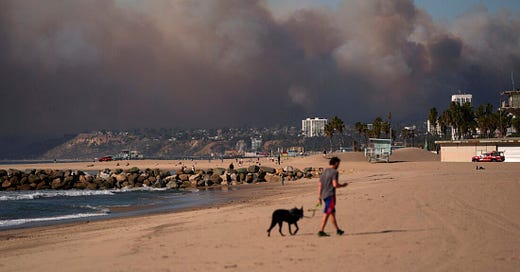Understanding Air Quality and Outdoor Safety in Los Angeles Amidst Wildfires
As wildfires continue to affect air quality in Los Angeles, many parents have expressed concerns about whether it is safe for their children to go outside. Given the complex nature of air quality issues, especially during wildfires, it's crucial to understand what the Air Quality Index (AQI) tells us and its limitations.
What is the AQI?
The AQI is a tool used by the Environmental Protection Agency (EPA) to provide the public with an indication of air quality on a scale from 0 to 500. The index is divided into six categories:
0-50: Good
51-100: Moderate
101-150: Unhealthy for Sensitive Groups
151-200: Unhealthy
201-300: Very Unhealthy
301-500: Hazardous
Each range corresponds to a different level of health concern, primarily based on concentrations of pollutants such as particulate matter (PM2.5 and PM10), ground-level ozone, carbon monoxide, sulfur dioxide, and nitrogen dioxide.
What AQI Doesn't Measure
While the AQI provides valuable information on these common pollutants, it does not account for specific toxins that wildfires can release into the air, such as volatile organic compounds (VOCs), polycyclic aromatic hydrocarbons (PAHs), and other harmful chemicals from burned materials including plastics. These substances can pose additional health risks, especially when they are not directly included in the AQI measurements.
The Real Impact of Fire-Related Pollutants
In areas close to wildfires, the concentration of unmeasured toxins like plastics and VOCs can significantly worsen the air quality beyond what the AQI indicates. These chemicals can be especially harmful to children, the elderly, and those with pre-existing health conditions, leading to respiratory issues and other health problems.
Indoor Air Quality
While staying indoors can somewhat reduce exposure to harmful air, it's not a foolproof solution. Using air purifiers with HEPA filters can help remove particulate matter from indoor air, but they may not be as effective against gases and smaller pollutants. Ensuring that your home's ventilation system is well-maintained and using indoor air purifiers can provide some degree of protection.
Guidance for Going Outside
If the AQI is in the "Unhealthy for Sensitive Groups" range or worse, it's advisable to keep children indoors as much as possible, especially those with respiratory conditions like asthma. If outdoor activities are necessary, try to limit them to shorter periods and during times when the AQI shows lower levels of pollution.
For families living several miles away from the immediate vicinity of active wildfires, the direct impact of smoke and related pollutants may be significantly lessened due to the dispersion of particles in the atmosphere. As smoke travels, larger particles tend to settle while smaller ones disperse over wide areas, diluting their concentration. This means that although the air quality may still show signs of pollution, the level of harmful particles and chemicals you are exposed to is much lower compared to areas closer to the fire. Consequently, while it is always prudent to stay informed and cautious, parents should not be overly worried if residing far from active fire zones. Keeping windows closed, monitoring local air quality indexes, and using indoor air purification systems can further minimize any residual risk from wildfire smoke.
Evacuation Considerations
For those living very close to active fire zones, especially downwind, evacuation might be the safest option. The proximity to intense smoke and fire can dramatically escalate potential health risks, and temporary relocation might be necessary until conditions improve.
Stress
It's also important to consider the role of stress in our overall health. Constantly worrying about air quality when you are miles away from the direct impact of a wildfire can actually be more detrimental to your health than the sporadic exposure to diluted air pollutants. Our bodies, and specifically our lungs, are equipped to handle various environmental elements, including low levels of pollutants, especially when not in the immediate vicinity of a source like a wildfire.
If the stress of the situation is overwhelming, it might be beneficial to use this as an opportunity for a short break or a "mini-vacation." Temporarily relocating to an area with better air quality can provide peace of mind and allow you to return once the air has cleared and the quality has improved. This not only helps reduce stress but also minimizes your exposure during the peak times of poor air quality. Remember, managing stress is just as crucial as managing physical health, and taking proactive steps to ensure your mental well-being is vital during these times.
In conclusion, while the AQI is a helpful tool for gauging air quality, it does not capture all the risks associated with wildfire smoke, especially concerning the fine particles and chemicals released from burning materials. It's crucial to stay informed through local health advisories and make decisions that prioritize the health and safety of your family. For those in Los Angeles dealing with current wildfire smoke, staying indoors, using air purifiers, and keeping track of both the AQI and local fire reports are key steps to mitigate exposure.
Stay safe and informed,
Dr. Joel Gator




